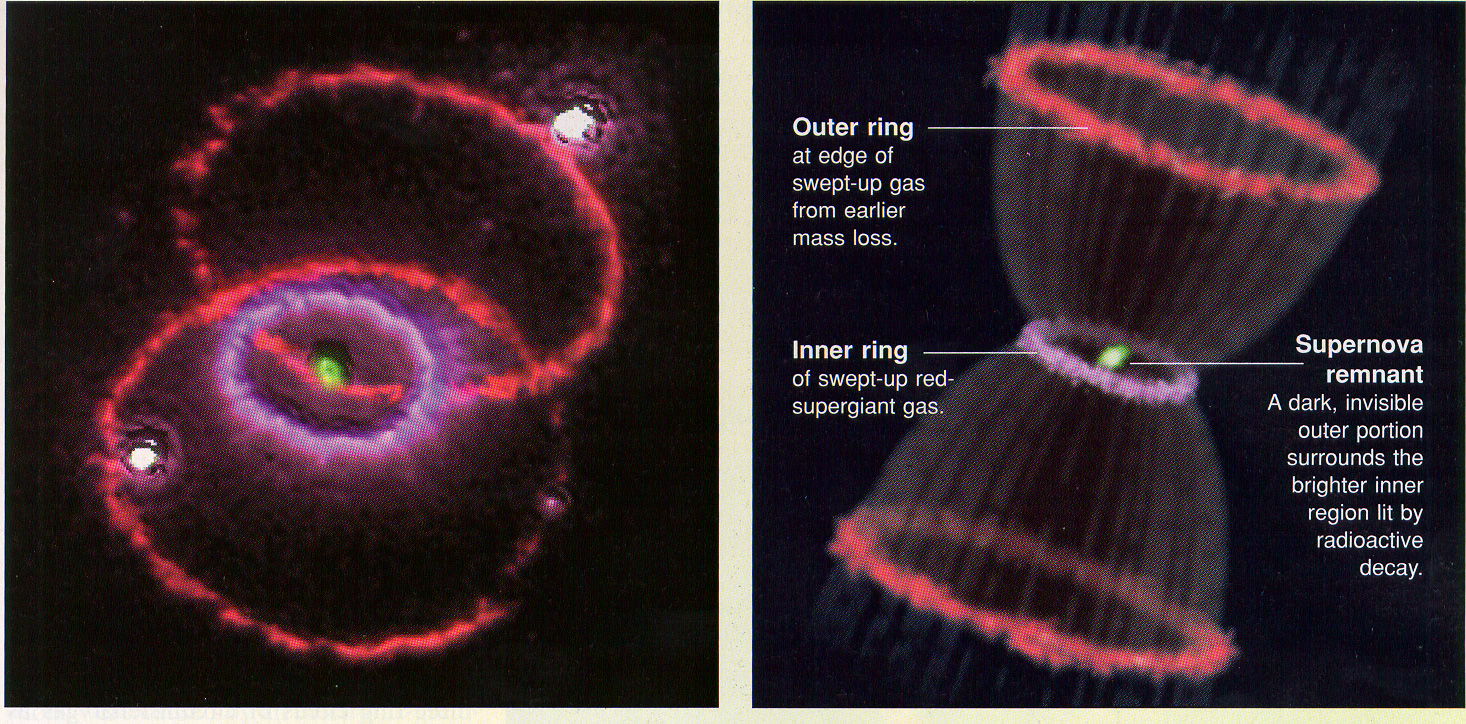Observing Supernova 1987A For 3 Decades – What We’ve Learned | Video
Video 3.44 min
Astronomer Remy Indebetouw explains what has occured in the observations of the exploded star since its discovery in 1987.
More…
Observing Supernova 1987A For 3 Decades – What We’ve Learned | Video
Video 3.44 min
Astronomer Remy Indebetouw explains what has occured in the observations of the exploded star since its discovery in 1987.
More…
Tau.Neutrino said:
Observing Supernova 1987A For 3 Decades – What We’ve Learned | VideoVideo 3.44 min
Astronomer Remy Indebetouw explains what has occured in the observations of the exploded star since its discovery in 1987.
More…
Thirty year anniversary. 23 Feb 1987. Happy birthday to you.
https://en.m.wikipedia.org/wiki/SN_1987A
the progenitor star was tentatively identified as Sanduleak −69° 202, a blue supergiant. After the supernova faded, that identification was definitely confirmed by Sanduleak −69° 202 having disappeared.
two to three hours before the visible light from SN 1987A reached Earth, a burst of neutrinos was observed at three separate neutrino observatories.
The Hubble Space Telescope has taken images of the supernova regularly since August 1990, but, so far, the images have shown no evidence of a neutron star.
All three of the above were totally unexpected.
The radioactive decay of 56Ni produces gamma-ray photons that are absorbed and dominate the heating and thus the luminosity of the ejecta from times of several weeks to several months. It is is currently powered by the radioactive decay of 44Ti .

The rings we see were actually created before the supernova. They are preexisting material lit up by the supernova. The irregular jumble of filaments growing rapidly in the centre is what the supernova actually produced.
When was the last image taken? There’s one dated 2006.
The following image was posted on the web in 2013. But was it photographed in 2013 or in 2006? The fish shape is the real supernova remnant, the rest is pre-ejected material.

Most recent confirmed image dates are 2009 for Hubble and 2011 for the VLT. The instrument used on the VLT is known as SINFONI.
That’s terrible. High quality images of such a rapidly evolving highly energetic object must be updated at least once a year.
mollwollfumble said:
Most recent confirmed image dates are 2009 for Hubble and 2011 for the VLT. The instrument used on the VLT is known as SINFONI.That’s terrible. High quality images of such a rapidly evolving highly energetic object must be updated at least once a year.
Ah, wait.
“This new image of the supernova remnant SN 1987A was taken by the NASA/ESA Hubble Space Telescope in Jan. 2017 using its Wide Field Camera 3 (WFC3). “
From https://m.phys.org/news/2017-02-hubble-captures-30th-anniversary-image.html

But – this is ridiculous, I can see at a glance that the visible image of SN 1987a that has just been released on 24 Feb 2017 is some twelve or so years old.

mollwollfumble said:
mollwollfumble said:
Most recent confirmed image dates are 2009 for Hubble and 2011 for the VLT. The instrument used on the VLT is known as SINFONI.That’s terrible. High quality images of such a rapidly evolving highly energetic object must be updated at least once a year.
Ah, wait.
“This new image of the supernova remnant SN 1987A was taken by the NASA/ESA Hubble Space Telescope in Jan. 2017 using its Wide Field Camera 3 (WFC3). “
From https://m.phys.org/news/2017-02-hubble-captures-30th-anniversary-image.html
But – this is ridiculous, I can see at a glance that the visible image of SN 1987a that has just been released on 24 Feb 2017 is some twelve or so years old.
Supernova indicates to me an almighty boom. Even with the light being distant the events should still play put in real time as observed.
That’s less a kaboom and more of a slow moving pffffft.
AwesomeO said:
Supernova indicates to me an almighty boom. Even with the light being distant the events should still play put in real time as observed.That’s less a kaboom and more of a slow moving pffffft.
Ah yes, but see how fast the fish grows.
The ring was already present before the supernova, at a radius of exactly 0.66 light years. The fastest ejecta is travelling at 7,000 km/s, 2.3% of the speed of light. The fish is expanding more slowly than that, with the tail expanding at 1.5% of the speed of light.
So, although the rings are growing fairly slowly, giving the appearance of a “slow moving pffffft”, what’s happening within definitely qualifies as a “kaboom”.
Quite. An explosion with a front moving at tens of millions of km per hour is quite kaboom enough.
dv said:
Quite. An explosion with a front moving at tens of millions of km per hour is quite kaboom enough.
And it would have sound within all that activity, but no way to hear it of course.
This may be the genuine 2017 image. I cut it from a wider field of view image.

The fish is only barely visible, but its tail has reached the edge of the inner ring.